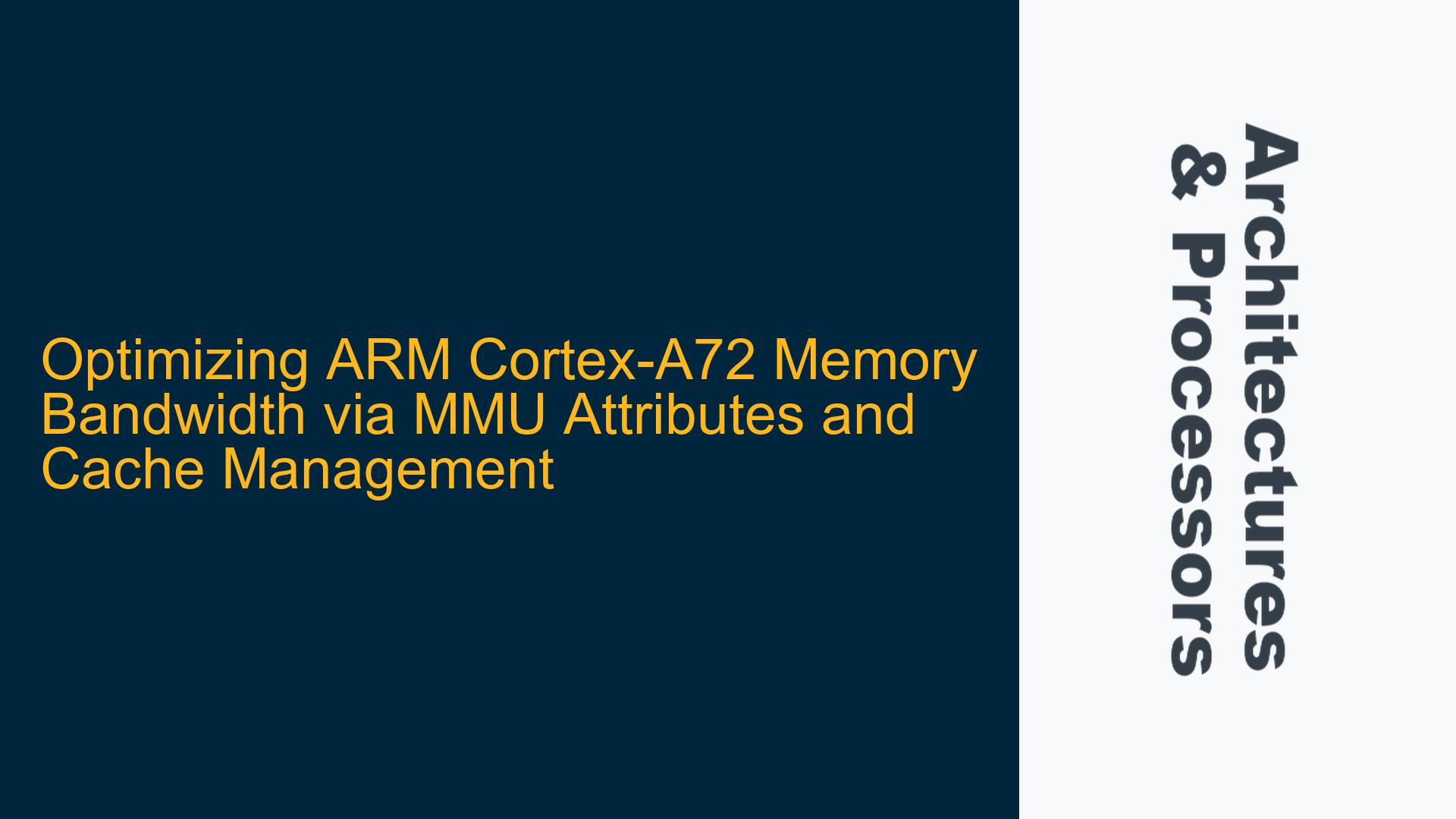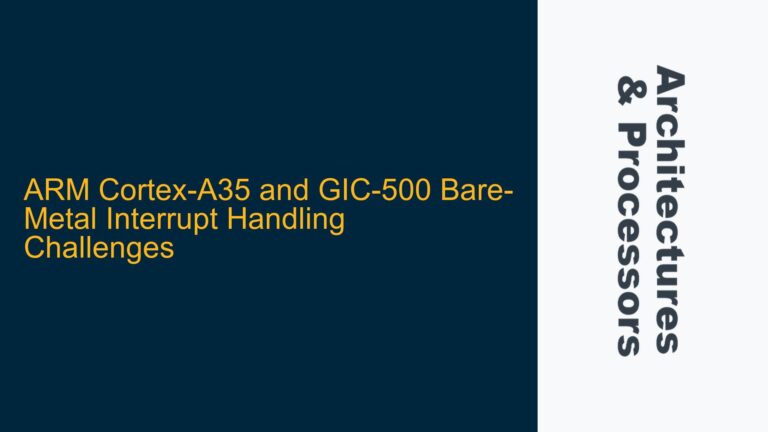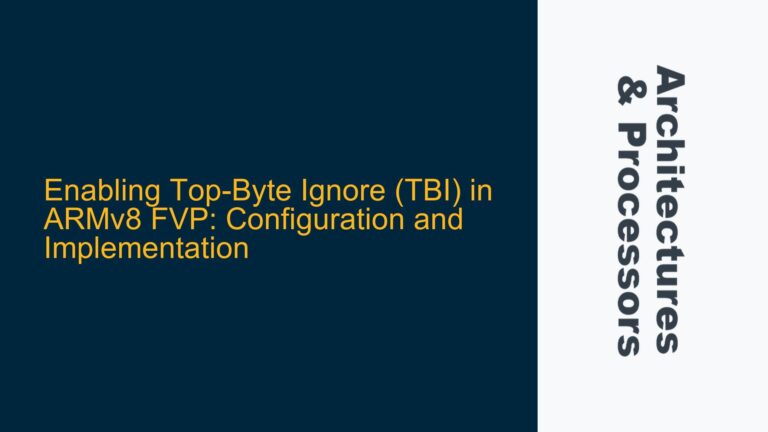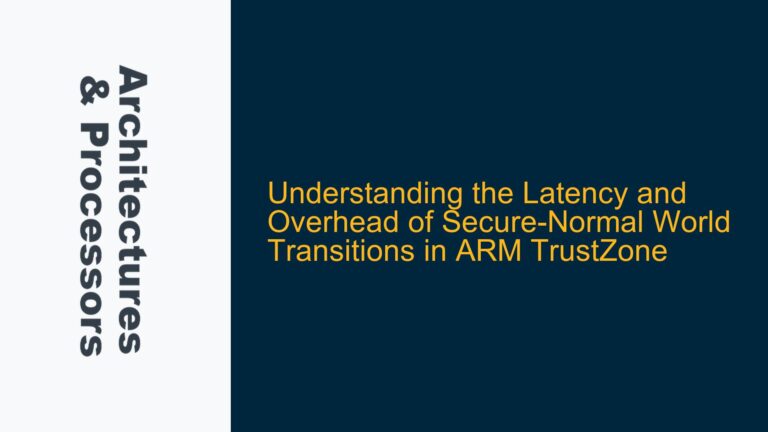ARM Cortex-A72 Memory Bandwidth Degradation with Disabled MMU
When working with ARM Cortex-A72 processors in a multi-core system, memory bandwidth optimization is critical for achieving peak performance, especially in bare-metal applications that rely heavily on external L3 memory access. A common issue arises when the Memory Management Unit (MMU) is disabled, leading to significant memory bandwidth degradation. This degradation occurs because disabling the MMU forces all memory accesses to be treated as Device nGnRnE (Non-cacheable, Non-gathering, Non-reordering, Early Write Acknowledgment), which is the most restrictive memory type. Device nGnRnE memory attributes impose strict ordering and non-cacheable behavior, resulting in suboptimal memory access patterns and reduced bandwidth.
The ARM Cortex-A72 architecture relies on the MMU to define memory attributes for different regions of the address space. These attributes control how memory accesses are handled, including cacheability, shareability, and memory type (Normal or Device). When the MMU is disabled, the system defaults to treating all memory as Device nGnRnE, which is designed for memory-mapped I/O devices rather than high-performance memory access. This default behavior prevents the use of caches and optimizations like write-combining, leading to increased latency and reduced throughput.
To achieve maximum memory bandwidth, it is essential to configure the MMU with appropriate memory attributes for the target memory regions. This involves selecting between Normal Non-cacheable and Normal Cacheable memory types, depending on the specific use case. Normal Non-cacheable memory is suitable for scenarios where caching is undesirable, such as when accessing memory-mapped I/O or shared memory regions. Normal Cacheable memory, on the other hand, allows the use of L1 and L2 caches to reduce latency and improve bandwidth for frequently accessed data.
Impact of Device nGnRnE Memory Type and MMU Configuration
The primary cause of memory bandwidth degradation in the described scenario is the use of Device nGnRnE memory type when the MMU is disabled. This memory type enforces strict access ordering and prevents caching, which is detrimental to performance in systems that rely on high-speed memory access. The ARM Cortex-A72 processor’s memory subsystem is designed to leverage cache hierarchies and memory access optimizations, which are unavailable when the MMU is disabled.
Another contributing factor is the lack of proper cache management. When the MMU is enabled, the page table entries define the cacheability and shareability attributes for each memory region. These attributes determine whether data is cached in L1 or L2 caches and whether it is shared between multiple cores. Without proper MMU configuration, the system cannot take advantage of these optimizations, leading to inefficient memory access patterns.
Additionally, the ARM Cortex-A72’s memory controller and L3 cache play a crucial role in determining memory bandwidth. The memory controller handles read and write requests to external memory, while the L3 cache acts as a shared resource for multiple cores. The performance of these components is heavily influenced by the memory attributes defined in the MMU. For example, Normal Cacheable memory allows the memory controller to use burst transfers and other optimizations, while Device nGnRnE memory forces single-cycle accesses with strict ordering.
To maximize memory bandwidth, it is essential to configure the MMU with appropriate memory attributes and ensure proper cache management. This involves selecting the correct memory type (Normal Non-cacheable or Normal Cacheable) and configuring the cacheability and shareability attributes for each memory region. Additionally, the system must handle cache coherency and invalidation properly to avoid performance bottlenecks.
Configuring MMU Attributes and Cache Management for Maximum Bandwidth
To address the memory bandwidth degradation issue, the MMU must be configured with optimal memory attributes, and cache management must be implemented effectively. The following steps outline the process for achieving maximum memory bandwidth on an ARM Cortex-A72 system:
-
Enable the MMU and Configure Page Tables: The first step is to enable the MMU and configure the page tables with appropriate memory attributes. For memory regions that require high bandwidth, use Normal Cacheable memory with the appropriate cacheability and shareability attributes. This allows the processor to use L1 and L2 caches to reduce latency and improve throughput. For regions that do not benefit from caching, such as memory-mapped I/O, use Normal Non-cacheable memory.
-
Select Optimal Memory Attributes: The memory attributes defined in the page table entries control how memory accesses are handled. For Normal Cacheable memory, set the cacheability attribute to "Write-Back, Write-Allocate" to enable write-combining and reduce the number of write transactions. Set the shareability attribute to "Inner Shareable" to allow multiple cores to access the same memory region efficiently. For Normal Non-cacheable memory, ensure that the memory type is set to "Normal" and the cacheability attribute is set to "Non-cacheable."
-
Implement Cache Management Strategies: Proper cache management is essential for maximizing memory bandwidth. Use cache maintenance operations to ensure that data is written back to memory and invalidated when necessary. For example, use the Data Cache Clean and Invalidate by Set/Way (DC CISW) instruction to clean and invalidate the entire data cache before performing large memory transfers. Additionally, use the Data Synchronization Barrier (DSB) instruction to ensure that all memory accesses are completed before proceeding to the next operation.
-
Optimize Memory Access Patterns: The order and alignment of memory accesses can significantly impact bandwidth. Use sequential access patterns to take advantage of burst transfers and reduce the number of memory transactions. Align data structures to cache line boundaries to minimize cache line fills and evictions. Avoid random access patterns that can lead to cache thrashing and reduced performance.
-
Monitor and Tune Performance: Use performance monitoring tools to measure memory bandwidth and identify bottlenecks. The ARM Cortex-A72 provides Performance Monitoring Units (PMUs) that can be used to track cache hits, misses, and memory access latency. Analyze the performance data to identify areas for improvement and adjust the MMU configuration and cache management strategies accordingly.
By following these steps, you can configure the MMU and cache management to achieve maximum memory bandwidth on an ARM Cortex-A72 system. Proper MMU configuration and cache management are essential for optimizing memory access patterns and leveraging the full potential of the processor’s memory subsystem.
Detailed Explanation of Memory Attributes and Their Impact
To fully understand the impact of MMU attributes on memory bandwidth, it is necessary to delve into the details of memory types and their associated attributes. The ARM architecture defines several memory types, including Normal, Device, and Strongly Ordered. Each memory type has specific characteristics that influence how memory accesses are handled.
Normal Memory: Normal memory is used for general-purpose data storage and is typically cacheable. It allows the processor to use caches to reduce latency and improve bandwidth. Normal memory can be further classified as Write-Back (WB), Write-Through (WT), or Write-Allocate (WA), depending on the cacheability attributes. Write-Back memory allows the processor to write data to the cache and defer writing to main memory until the cache line is evicted. Write-Through memory requires the processor to write data to both the cache and main memory simultaneously. Write-Allocate memory allocates a cache line on a write miss, allowing subsequent writes to be cached.
Device Memory: Device memory is used for memory-mapped I/O devices and has strict access ordering requirements. It is non-cacheable and non-bufferable, meaning that each access must be performed in the exact order specified by the program. Device memory can be further classified as nGnRnE, nGnRE, or GRE, depending on the level of reordering and gathering allowed. nGnRnE memory is the most restrictive, requiring strict ordering and early write acknowledgment. nGnRE memory allows some reordering of reads but not writes. GRE memory allows both reads and writes to be reordered.
Strongly Ordered Memory: Strongly Ordered memory is similar to Device memory but has even stricter ordering requirements. It is used for critical system resources that must be accessed in a specific order, such as interrupt controllers and system registers. Strongly Ordered memory is non-cacheable and non-bufferable, and all accesses must be performed in program order.
The choice of memory type and attributes has a significant impact on memory bandwidth. Normal Cacheable memory with Write-Back and Write-Allocate attributes provides the highest bandwidth by allowing the processor to use caches and write-combining optimizations. Normal Non-cacheable memory provides lower bandwidth but is suitable for regions that do not benefit from caching. Device and Strongly Ordered memory provide the lowest bandwidth due to their strict access ordering requirements and lack of caching.
Practical Example: Configuring MMU Attributes for High Bandwidth
To illustrate the process of configuring MMU attributes for high bandwidth, consider a bare-metal application that performs large memory transfers between the ARM Cortex-A72 processor and external L3 memory. The goal is to maximize memory bandwidth by configuring the MMU with optimal memory attributes and implementing effective cache management.
-
Define Memory Regions: Identify the memory regions that will be used for the memory transfers. For example, define a region for the source data and a region for the destination data. Ensure that these regions are aligned to cache line boundaries to minimize cache line fills and evictions.
-
Configure Page Table Entries: Create page table entries for the memory regions and set the appropriate memory attributes. For the source and destination regions, use Normal Cacheable memory with Write-Back and Write-Allocate attributes. Set the shareability attribute to Inner Shareable to allow multiple cores to access the regions efficiently. For any memory-mapped I/O regions, use Normal Non-cacheable memory.
-
Enable the MMU: Enable the MMU and load the page table base address into the Translation Table Base Register (TTBR). Ensure that the MMU is configured to use the new page table entries.
-
Implement Cache Maintenance: Before performing the memory transfers, clean and invalidate the data cache to ensure that all data is written back to memory and that the cache is in a known state. Use the DC CISW instruction to clean and invalidate the entire data cache. After the memory transfers, invalidate the cache again to ensure that any stale data is removed.
-
Optimize Memory Access Patterns: Use sequential access patterns to take advantage of burst transfers and reduce the number of memory transactions. Align data structures to cache line boundaries to minimize cache line fills and evictions. Avoid random access patterns that can lead to cache thrashing and reduced performance.
-
Monitor Performance: Use the ARM Cortex-A72’s Performance Monitoring Units (PMUs) to track cache hits, misses, and memory access latency. Analyze the performance data to identify areas for improvement and adjust the MMU configuration and cache management strategies accordingly.
By following these steps, you can configure the MMU and cache management to achieve maximum memory bandwidth on an ARM Cortex-A72 system. Proper MMU configuration and cache management are essential for optimizing memory access patterns and leveraging the full potential of the processor’s memory subsystem.
Conclusion
Optimizing memory bandwidth on ARM Cortex-A72 processors requires a deep understanding of MMU attributes and cache management. Disabling the MMU forces all memory accesses to be treated as Device nGnRnE, leading to significant bandwidth degradation. To achieve maximum bandwidth, the MMU must be configured with appropriate memory attributes, and cache management must be implemented effectively. By enabling the MMU, selecting optimal memory attributes, and optimizing memory access patterns, you can leverage the full potential of the ARM Cortex-A72’s memory subsystem and achieve peak performance in bare-metal applications.






